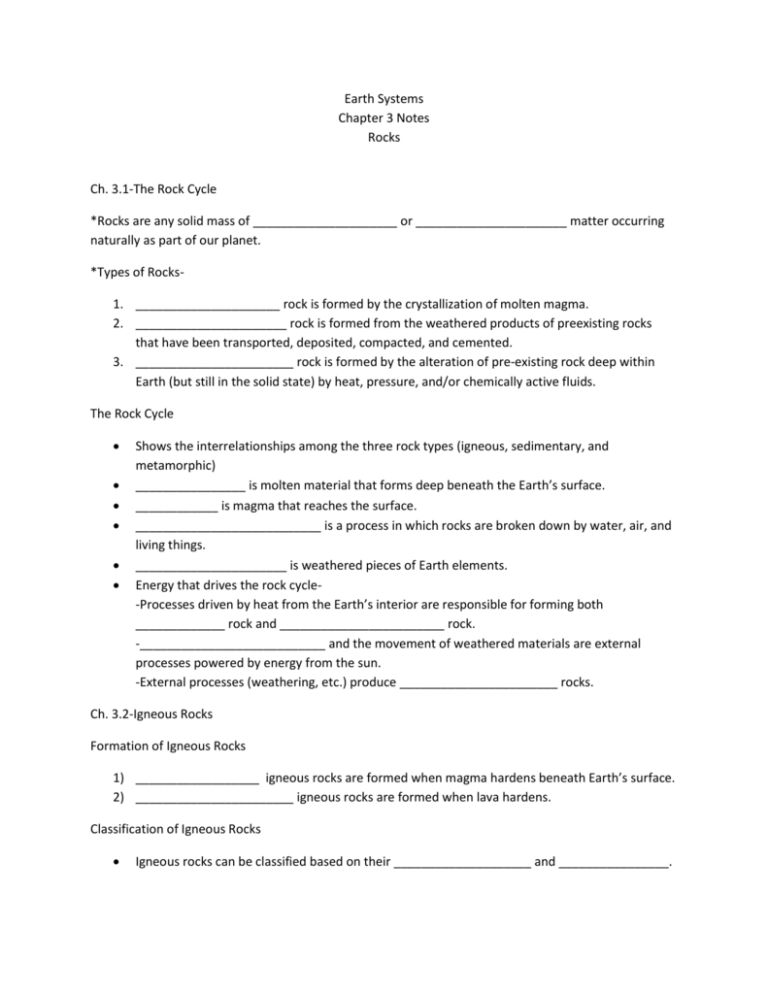Ch. 3 Notes
advertisement

Earth Systems Chapter 3 Notes Rocks Ch. 3.1-The Rock Cycle *Rocks are any solid mass of _____________________ or ______________________ matter occurring naturally as part of our planet. *Types of Rocks1. _____________________ rock is formed by the crystallization of molten magma. 2. ______________________ rock is formed from the weathered products of preexisting rocks that have been transported, deposited, compacted, and cemented. 3. _______________________ rock is formed by the alteration of pre-existing rock deep within Earth (but still in the solid state) by heat, pressure, and/or chemically active fluids. The Rock Cycle Shows the interrelationships among the three rock types (igneous, sedimentary, and metamorphic) ________________ is molten material that forms deep beneath the Earth’s surface. ____________ is magma that reaches the surface. ___________________________ is a process in which rocks are broken down by water, air, and living things. ______________________ is weathered pieces of Earth elements. Energy that drives the rock cycle-Processes driven by heat from the Earth’s interior are responsible for forming both _____________ rock and ________________________ rock. -___________________________ and the movement of weathered materials are external processes powered by energy from the sun. -External processes (weathering, etc.) produce _______________________ rocks. Ch. 3.2-Igneous Rocks Formation of Igneous Rocks 1) __________________ igneous rocks are formed when magma hardens beneath Earth’s surface. 2) _______________________ igneous rocks are formed when lava hardens. Classification of Igneous Rocks Igneous rocks can be classified based on their ____________________ and ________________. 1) Texture Coarse-grained texture is caused by slow cooling resulting in ________________ crystals (_____________________). Fine-grained texture is caused by rapid cooling resulting in __________________, interconnected mineral grains (________________________). _______________________ texture is caused by very rapid cooling. ______________________________ texture is caused by different rates of cooling resulting in varied sized minerals. 2) Composition _________________ composition rocks are made mostly of light-colored ________________ and _______________________. _______________________ composition rocks are made mostly of dark-colored silicate minerals and plagioclase feldspar. _______________________composition rocks are between granitic light-color minerals and basaltic composition dark-colored minerals. ___________________________ composition rocks are made mostly from iron and magnesium-rich minerals. Ch. 3.2-Sedimentary Rocks Formation of Sedimentary Rocks ___________________________ is a process that squeezes, or compacts, sediments. ______________________________ takes place when dissolved minerals are deposited in the tiny spaces among the sediments. _____________________________ involves the weathering and the removal of rock. _________________________ occurs when an agent of erosion—water, wind, ice, or gravity— loses energy and drops sediments. Two Main Groups of sedimentary rocks 1) _______________________ sedimentary rocks are composed of weathered bits of rocks and minerals. Classified by _________________ size Common rocks include: ______________________(most abundant) ___________________________ ___________________________ 2) ____________________________ sedimentary rocks form when dissolved substances precipitate, or separate, from water. Common rocks include: _______________________—most abundant chemical rock microcrystalline __________________ known as chert, flint, jasper, or agate _______________________such as rock salt or gypsum _________________________ Features of sedimentary rocks are clues to _______________ and _____________________ the rocks are formed _________________________________ are only found in sedimentary rocks – Why? Ch. 3.4-Metamorphic Rocks Formation of Metamorphic Rocks Metamorphism means “_______________________________________________.” Most metamorphic changes occur at elevated ____________________________and_____________________________. Conditions for formation are found a few kilometers below the Earth’s surface and extend into the upper mantle. 1) ____________________________________ metamorphism occurs when magma moves into rock. o Occurs near a body of magma o Changes are driven by a rise in __________________________. 2) ___________________________________ metamorphism results in large-scale deformation and high-grade metamorphism. o Directed pressures and high temperatures occur during ___________________________________________. o Produces the greatest ____________________________________ of metamorphic rock. Agents of Metamorphism 1) Heat o Provides the ________________ needed to drive chemical reactions 2) Pressure o Causes a more ____________________rock with greater density 3) Hydrothermal Solutions o Hot water-based solutions escaping from the mass of _________________ promote recrystallization by _________________ original minerals and then ___________________________ new ones. Classification of Metamorphic Rocks Two main categories: 1) _____________________________ Metamorphic Rock o Has a banded or layered appearance 2) ________________________________________ Metamorphic Rock o Does not have a banded texture







